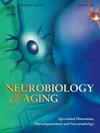Calcineurin/NFAT inhibitors maintain cognition in a preclinical prevention study in an aging canine model of Alzheimer disease
IF 3.7
3区 医学
Q2 GERIATRICS & GERONTOLOGY
引用次数: 0
Abstract
Brain signaling of calcineurin (CN) and nuclear factor of activated T-cells (NFAT) transcription factor increases in Alzheimer disease (AD) and is associated with synaptic loss, neurodegeneration, neuroinflammation, amyloid-β (Aβ) production, and cognitive decline. CN/NFAT inhibitors ameliorate these neuropathologies in mouse models of AD. Further, chronic use of tacrolimus in transplant patients reduces risk of AD. Beagles naturally develop Aβ plaques and cognitive dysfunction. We evaluated the impact of FDA-approved CN inhibitor, tacrolimus, and experimental NFAT inhibitor, Q134R, on cognitive outcomes during a three-year prevention study in 37 middle-aged beagles. While beagles treated with CN/NFAT inhibitors showed differences in the pattern of cognitive maintenance and duration of their effect, there was improvement in spatial learning, as well as maintenance of memory, attention, and working memory relative to placebo dogs. CN/NFAT inhibition is a promising target for prevention of cognitive decline that may be rapidly implemented in human clinical trials.
钙神经蛋白/NFAT抑制剂可在老年痴呆症犬模型的临床前预防研究中维持认知能力。
在阿尔茨海默病(AD)中,脑内钙神经蛋白(CN)和活化T细胞核因子(NFAT)转录因子的信号增强,并与突触丢失、神经变性、神经炎症、淀粉样蛋白-β(Aβ)生成和认知能力下降有关。CN/NFAT抑制剂可改善AD小鼠模型中的这些神经病理变化。此外,移植患者长期使用他克莫司可降低罹患注意力缺失症的风险。比格犬会自然形成 Aβ 斑块和认知功能障碍。我们评估了美国 FDA 批准的 CN 抑制剂他克莫司和实验性 NFAT 抑制剂 Q134R 对 37 只中年比格犬在为期三年的预防研究中认知结果的影响。虽然接受 CN/NFAT 抑制剂治疗的猎犬在认知能力维持模式和效果持续时间上存在差异,但与安慰剂犬相比,它们的空间学习能力以及记忆力、注意力和工作记忆的维持能力都有所改善。CN/NFAT抑制剂是一种很有前景的预防认知能力下降的靶点,可迅速用于人类临床试验。
本文章由计算机程序翻译,如有差异,请以英文原文为准。
求助全文
约1分钟内获得全文
求助全文
来源期刊

Neurobiology of Aging
医学-老年医学
CiteScore
8.40
自引率
2.40%
发文量
225
审稿时长
67 days
期刊介绍:
Neurobiology of Aging publishes the results of studies in behavior, biochemistry, cell biology, endocrinology, molecular biology, morphology, neurology, neuropathology, pharmacology, physiology and protein chemistry in which the primary emphasis involves mechanisms of nervous system changes with age or diseases associated with age. Reviews and primary research articles are included, occasionally accompanied by open peer commentary. Letters to the Editor and brief communications are also acceptable. Brief reports of highly time-sensitive material are usually treated as rapid communications in which case editorial review is completed within six weeks and publication scheduled for the next available issue.
 求助内容:
求助内容: 应助结果提醒方式:
应助结果提醒方式:


